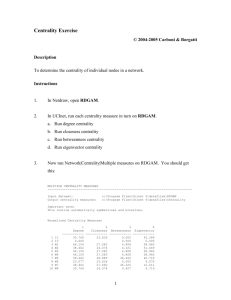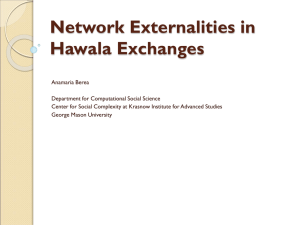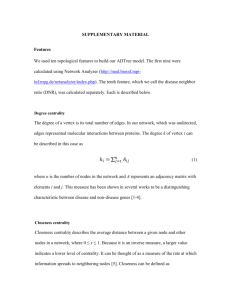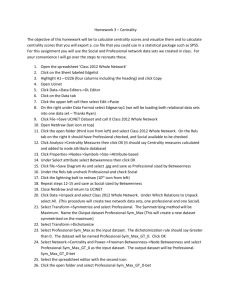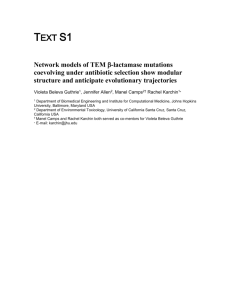A Centrality Measure in Currency Exchange Rate (Ukuran
advertisement
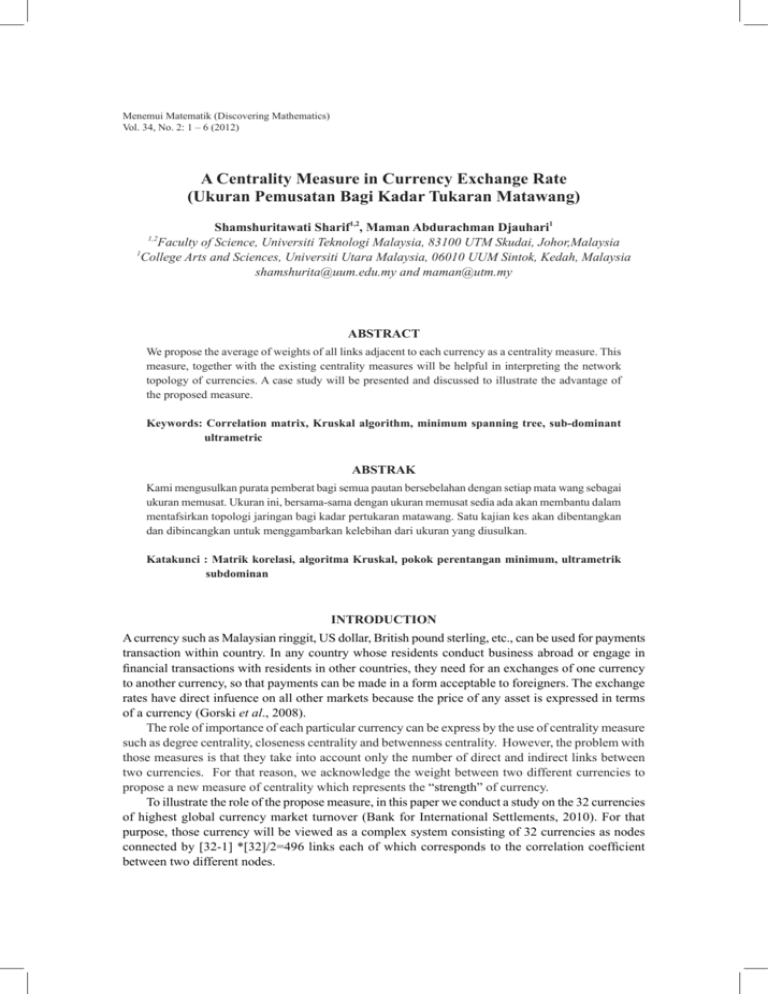
Menemui Matematik (Discovering Mathematics) Vol. 34, No. 2: 1 – 6 (2012) A Centrality Measure in Currency Exchange Rate (Ukuran Pemusatan Bagi Kadar Tukaran Matawang) Shamshuritawati Sharif1,2, Maman Abdurachman Djauhari1 Faculty of Science, Universiti Teknologi Malaysia, 83100 UTM Skudai, Johor,Malaysia 1 College Arts and Sciences, Universiti Utara Malaysia, 06010 UUM Sintok, Kedah, Malaysia shamshurita@uum.edu.my and maman@utm.my 1,2 ABSTRACT We propose the average of weights of all links adjacent to each currency as a centrality measure. This measure, together with the existing centrality measures will be helpful in interpreting the network topology of currencies. A case study will be presented and discussed to illustrate the advantage of the proposed measure. Keywords: Correlation matrix, Kruskal algorithm, minimum spanning tree, sub-dominant ultrametric ABSTRAK Kami mengusulkan purata pemberat bagi semua pautan bersebelahan dengan setiap mata wang sebagai ukuran memusat. Ukuran ini, bersama-sama dengan ukuran memusat sedia ada akan membantu dalam mentafsirkan topologi jaringan bagi kadar pertukaran matawang. Satu kajian kes akan dibentangkan dan dibincangkan untuk menggambarkan kelebihan dari ukuran yang diusulkan. Katakunci : Matrik korelasi, algoritma Kruskal, pokok perentangan minimum, ultrametrik subdominan INTRODUCTION A currency such as Malaysian ringgit, US dollar, British pound sterling, etc., can be used for payments transaction within country. In any country whose residents conduct business abroad or engage in financial transactions with residents in other countries, they need for an exchanges of one currency to another currency, so that payments can be made in a form acceptable to foreigners. The exchange rates have direct infuence on all other markets because the price of any asset is expressed in terms of a currency (Gorski et al., 2008). The role of importance of each particular currency can be express by the use of centrality measure such as degree centrality, closeness centrality and betwenness centrality. However, the problem with those measures is that they take into account only the number of direct and indirect links between two currencies. For that reason, we acknowledge the weight between two different currencies to propose a new measure of centrality which represents the “strength” of currency. To illustrate the role of the propose measure, in this paper we conduct a study on the 32 currencies of highest global currency market turnover (Bank for International Settlements, 2010). For that purpose, those currency will be viewed as a complex system consisting of 32 currencies as nodes connected by [32-1] *[32]/2=496 links each of which corresponds to the correlation coefficient between two different nodes. Shamshuritawati Sharif and Maman Abdurachman Djauhari . The nodes and links will be considered as a network or, more specifically, a weighted undirected graph (Jayawant & Glavin, 2009). This point of view is useful in order to visualize, simplify, and summarize the most important information contained in that complex system. The rest of paper is organized as follows. In Section 2 we discuss the analysis of that complex system by using the propose centrality measure as well as the current existing measures. To illustrate the advantage of the proposed measure, a case study on currency exchange rate will be presented and discussed in Section 3. At the end of this paper, we will draw attention to a conclusion. PROPOSED CENTRALITY MEASURE In this section we discuss the analysis of a complex system by using network topology approach. This allows us to visualize and simplify a complex system, and to summarize the information contained therein. We show that the centrality measures usually used as the principal tools to summarize the information are not sufficient. This motivate us to propose another measure. Network Topology The essence of a network is its nodes (currencies) and the way how they are linked. Network analysis was originally developed in computer science (De Nooy et al., 2004). Nowadays, it has been used in various fields of study. See, for example, Krichel & Bakkalbasi (2006) in sociology, Mantegna (1999) and Miccichè et al. (2003) in finance, and Park & Yilmaz (2010) in transportation. In financial industry, network analysis starts with correlation matrix followed by transforming it into a distance matrix (Mantegna & Stanley, 2000). From this matrix we construct a minimum spanning tree (MST) and the corresponding sub-dominant ultrametric (SDU) distance matrix. For this purpose we use Kruskal algorithm (Kruskal, 1956) as suggested in Mantegna & Stanley (2000) and Jayawant & Glavin (2009). MST will then be used to construct network topology of currencies. This is a simplification of the complex system of currencies and their correlation structure which will be used to summarize the most important information. The visualization of MST can be made possible by using the open source called ‘Pajek’ (Batagelj & Mrvar, 2003; Batagelj & Mrvar, 2011 and De Nooy et al., 2004). Furthermore, to interpret the MST we use the standard tools, i.e., centrality measures. To make the network topology more attractive and easy to interpret, we use the Kamada Kawai procedure provided in Pajek (Kamada & Kawai, 1989). Centrality Measures From network analysis view point, the role or degree of importance of each particular node can be analyzed by using its centrality measures such as degree, betweenness, and closeness centralities. These will help us to find the most important nodes in the network structure (Xu et al., 2009; Abbasi & Altmann, 2010; Monárrez-Espino & Caballero-Hoyos, 2010). Degree centrality indicates the connectivity of nodes. It provides information on how many other nodes are connected with a particular node. On the other hand, betweenness centrality is reflects the extent to which a node lies in relative position with respect to the others (Freeman, 1977). This measure indicates the potentiality of node to influence the others. Closeness centrality measures how close a node is to all other nodes in terms of correlations. Closeness can also be regarded as a measure of how long the information is to spread from a given node to other reachable nodes. Those measures are computed based on the MST as follows (Borgatti, 1995; Sieczka & Holyst, 2009; and Park & Yilmaz, 2010): n i. Degree centrality of node i is d = / a where aij = 1 if the i-th and j-th nodes are linked and j=1 0 otherwise. ij 2 Menemui Matematik Vol. 34 (1) 2012 A Centrality Measure in Currency Exchange Rate ii. Betweenness centrality of node i, bi, is the ratio of the number of path passing through i between two different nodes and the number of all possible paths from j to k for all j and k where j!i and k!i. iii. Closeness centrality of node i, ci, is the ratio of the number of links in the MST, which is equal to (n-1), and the number of links in the path from i to j for all j!i. Degree centrality is the simplest of the node centrality measures by using the local structure around nodes only. In order to identify the role of importance, degree centrality is no longer appropriate to be the best measure. The higher the degree centrality does not reflect to the strength of each particular node. Due to that limitation of degree centrality, in this subsection we introduce “average of weights” as another measure. It is the average of weights of all links adjacent to each node. This measure reflects the strength of influence of a particular node to the others. The node that has larger scores in all measures is considered to be more central in terms of it influence to the others. A CASE STUDY As a case study, 32 currency exchange rate of highest global market turnover (Bank for International Settlements, 2010) will be analyzed. The sampling period of the data collection is taken in daily basis from February 1, 2000 to April 28, 2011 from Sauder School of Business (2011). In general there are 5 trading days per week and about 20 trading days per month. In this analysis, Gold Ounces (XAU) is used as the currency base. Based on the MST issued from Matlab version 7.8.0 (R2009a), see Figure 1, in Appendix we present the centrality measure discussed previously. In Figure 1 (a) – (d) we present the MST together with the results in Appendix. The size and colour of the node represent the score of centrality measure and the rank of importance for degree centrality, betwenness centrality, closeness centrality and average of weight centrality. From that Figure, we learn that: 1. Based on degree centrality, see Figure 1 (a), SGD and MYR (red points) have the highest number of links (6) in the network. HKD (yellow point) and EUR (blue point) are 5 and 4 links respectively. Each of the followings has 3 links: MXN, DKK, and TWD (green points). The rests are of 1 and 2 links only. The higher the number of links, the higher the influence of a particular currency. 2. In terms of betweenness, see Figure 1 (b), SGD (red point) has an excellent position compared to the others where the information flow in the network can easily reach others. This node is the closest node to the others. The second (third, fourth, and fifth, respectively) closest node to the others are HKD (yellow point) (CNY (blue point), MYR (green point) and all purple points (USD, GBP and EUR), respectively). 3. According to the closeness centrality, see Figure 1 (c), the two most important nodes are SGD and CNY (red point) plays the most important role in the network followed by, in order of importance: HKD (yellow points or the second most important), GBP and USD (blue point or the third most important). This means that those currencies strongly influence the others. 4. Average of weight centrality can be used to indicate the average correlations between a particular node and the other nodes adjacent to it. In terms of degree, SGD and MYR are the most influential variables while in terms of sum of weights the most influential is TRY (red point), followed by ZAR, (yellow points), IDR and MXN (blue points) as well as BRL (green point). See Figure 1 (d). Menemui Matematik Vol. 34 (1) 2012 3 Shamshuritawati Sharif and Maman Abdurachman Djauhari . (a) (b) (c) (d) Figure 1: A network topology of 32 currency exchange rates and centrality measure Figure 1 (a) and 1 (d) represent an MST with degree centrality and average of weights, respectively. If degree centrality refer to the number of links adjacent to a node, average of weights is the sum of those links’ weight divided by the number of links. The latter measure represent the average influence given by a node to the others adjacent to it. From Appendix, we see its advantage compared to the former and learn that those measures are different. CONCLUSION We have introduced “average of weights” as a new centrality measure. Its advantage is illustrated by using 32 currencies of highest global market turnover where, together with the other established centrality measures, could help to enrich the economic interpretation of network topology. According to the four centrality measures, after using the Pareto analysis based on the ten currencies of highest scores in each centrality measures, see Appendix, the following 13 currencies are the vital few in influencing global currency market; EUR, GBP, HKD, MXN, SGD, TWD, USD, CAD, CNY, DKK, JPY, MYR and AUD. These 13 currencies should be paid more attention by the investors. 4 Menemui Matematik Vol. 34 (1) 2012 A Centrality Measure in Currency Exchange Rate ACKNOWLEDGMENT This research is sponsored by the Ministry of Higher Education of Malaysia under the FRGS vote numbers 78484 and 4F013. The authors gratefully acknowledge those sponsorships and Universiti Teknologi Malaysia. They also thank the reviewers for their helpful comments and suggestions. REFERENCES Abbasi, A. & Altmann, J. (2010). On the Correlation between Research Performance and Social Network Analysis Measures Applied to Research Collaboration Networks. TEMEP Discussion Paper, No.2010, Seoul National University, Korea. Bank for International Settlements (2010). Triennial Central Bank Survey: Foreign exchange and derivatives market activity in April 2010. http: http://www.bis.org/publ/rpfx10.pdf. (accessed on 25 June 2011). Batagelj, V., & Mrvar, A. (2003). A Density based approaches to network analysis: Analysis of Reuters terror news network, Ninth Annual ACM SIGKDD, Washington, D.C. Batagelj,V. & Mrvar, A. (2011). PAJEK: Program for Analysis and Visualization of Large Networks, version 2.02. http://pajek.imfm.si/doku.php?id=download (accessed on 6 January 2011). Borgatti, S.P. (1995). Centrality and AIDS. Connections, 18(1), 112-114. De Nooy, M., Mvrar, A. & Batagelj, V. (2004). Exploratory Social Network Analysis with Pajek. Cambridge: Cambridge University Press. Freeman, L.C. (1977). A set of measures of centrality based on betweenness. Sociometry, 40, 35-41. Górski, A.Z., Drożdż, S., Kwapień, J.& Oświęcimka, P. (2008). Minimal Spanning Tree Graphs and Power Like Scaling in FOREX Networks. Acta Physica Polonica A, 114(3), 531-538. Jayawant, P. & Glavin, K. (2009). Minimum spanning trees. Involve a journal of mathematics, 2(4), 439–450. Kamada, T. & Kawai, S. (1989). An algorithm for drawing general undirected graphs. Information Processing Letters (Elsevier), 31 (1), 7–15. Krichel, T. & Bakkalbasi, N. (2006). A Social Network Analysis of Research Collaboration in the Economics Community. The International Workshop on Webometrics, Informetrics and Scientometrics & Seventh COLLNET Meeting, France. Kruskal, J.B. (1956). On the shortest spanning subtree and the travelling salesman problem. Proceedings of the American Mathematical Society, 7(1), 48-50. Mantegna, R. N. (1999). Hierarchical Structure in Financial Markets. European Physical Journal B, 11, 193-197. Mantegna, R.N. & Stanley, H.E. (2000). An Introduction to Econophysics: Correlations and Complexity in Finance. Cambridge University Press, Cambridge UK. Miccichè, S., Bonanno, G., Lillo, F. & Mantegna, R.N. (2003). Degree stability of a minimum spanning tree of price return and volatility. Physica A, 324, 66–73. Monárrez-Espino, J. & Caballero-Hoyos, J. R. (2010). Stability of Centrality Measures in Social Network Analyses to Identify Long-Lasting Leaders from an Indigenous Boarding School of Northern Mexico. Estudios sobre las Culturas Contemporaneas, 16(32), 155-171. Park, K. & Yilmaz, A. (2010). A Social Network Analysis Approach to Analyze Road Networks. ASPRS Annual Conference. San Diego, CA. Sauder School of Business (2011). PACIFIC Exchange Rate Service, 2011. http://fx.sauder.ubc.ca (accessed on June 4, 2011). Sieczka,P. & Holyst, J.A. (2009). Correlations in commodity markets. Physica A, 388, 1621-1630. Xu, Y., Ma, J. Sun, Y., Hao, J., Sun, Y. & Zhao, Y. (2009). Using Social Network Analysis As A Strategy for E-Commerce Recommendation. Pacific Asia Conference on Information Systems (PACIS). India. Menemui Matematik Vol. 34 (1) 2012 5 Shamshuritawati Sharif and Maman Abdurachman Djauhari . APPENDIX Centrality measure Node 6 Currency Degree Betwenness Closeness Average 2 0.396 0.263 0.142 1 USD 2 EUR 4 0.391 0.235 0.342 3 JPY 1 0 0.235 0.547 4 GBP 2 0.396 0.267 0.474 5 AUD 2 0.065 0.199 0.512 6 CHF 1 0 0.191 0.318 7 CAD 2 0.125 0.242 0.547 8 HKD 5 0.624 0.298 0.223 9 SEK 2 0.065 0.168 0.598 10 NZD 1 0 0.167 0.429 11 KRW 1 0 0.194 0.531 12 SGD 6 0.658 0.304 0.445 13 NOK 1 0 0.167 0.407 14 MXN 3 0.127 0.194 0.643 15 INR 1 0 0.189 0.301 16 RUB 1 0 0.189 0.539 17 PLN 1 0 0.163 0.487 18 TRY 1 0 0.163 0.806 19 ZAR 1 0 0.145 0.786 20 BRL 1 0 0.163 0.617 21 DKK 3 0.185 0.199 0.294 22 TWD 3 0.127 0.238 0.406 23 HUF 2 0.065 0.194 0.507 24 CNY 2 0.516 0.304 0.170 25 MYR 6 0.400 0.231 0.461 26 THB 1 0 0.235 0.348 27 PHP 1 0 0.194 0.427 28 CLP 1 0 0.235 0.519 29 IDR 1 0 0.189 0.644 30 ILS 1 0 0.231 0.414 31 COP 1 0 0.189 0.541 32 SAR 1 0 0.231 0.317 Menemui Matematik Vol. 34 (1) 2012




